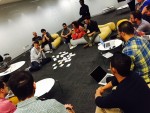Delight Your Stakeholders
Imagine you organized a dinner party for all stakeholders of your business. Shareholders, customers, suppliers, employees… everyone who is affected by your company is invited. Even the government, your local community and representatives of on-line communities are welcome. I would invite my spouse too. And the hamster.
Now imagine someone will ask the question, “what’s for dinner?”
Who will decide?
Jack Welch might say, “The shareholders get to choose what’s for dinner, because the party is financed with their money.”
Stephen Denning might say, “The customers get to choose, because the purpose of our business is to delight customers.”
Gary Hamel might say, “The employees get to choose what we’ll eat, because they are organizing the party.”
And I’m sure other people are able to come up with various reasons for suppliers, governments, and local and on-line communities to be allowed the final say over the dinner menu. I would tell you about the needs of my hamster.
Of course, you know better.
A business is a social network of stakeholders participating in freedom for mutual benefit of everyone involved. Nobody is more important than the others.
But Stephen Denning says you cannot please everyone:
The mathematics of optimization shows that only one variable can be maximized. […] It is not possible to maximize both client delight and shareholder value. You have to choose one or the other. (Radical Management, Kindle location: 1386)
Huh?
I wonder if Stephen Denning has any children. Will he always put the needs of the eldest first, because he doesn’t know how to optimize the needs of all children in his Excel spreadsheet? And will he just ask one party guest to decide what’s for dinner, because the problem of optimizing the sum of all needs across all guests is mathematically too hard for a manager?
That’s silly.
A traditional manager 1.0 might simply ignore stakeholders and follow his own personal agenda when making business decisions. A manager 2.0 might do better when trying to apply somewhat simplistic management advice, such as “optimize shareholder value” or “delight the client”. But I think a manager 3.0 will outperform all others. Because she understands a business is a complex adaptive system of stakeholders. They can all give and take, in endless iterations of collaboration, to please themselves and others.
A business is a non-zero sum game. You can and should delight everyone.
Including the hamster.
p.s. I actually like Stephen Denning’s book, Radical Management. You should read it! Just remember not to take its first principle (delight customers) too far.
(Jurgen Appelo is author of Management 3.0, a best-selling management book for Agile developers. It has a picture of a monster in it.)
(picture: Muffet)






